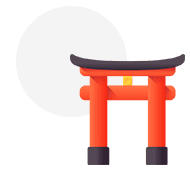
Study in Japan

The Second-largest developed economy in the world.

The 3rd largest Automobile manufacturing country in the world

5 Japanese Universities in the Top 100 QS Global Universities ranking 2023.

Over 700 globally-acclaimed universities to choose from.

Home to the largest electronics goods industry across the globe.

A Total of 242,444 International students studying in Japan as of 2021.
Japan, an island country is situated off the east coast of Asia. The Japanese territory is located in the region called Northeast Asia or East Asia, to the east of the Eurasian continent. It is surrounded by the Pacific Ocean, the Sea of Okhotsk, the Sea of Japan, and the East China Sea.
It consists of a collection of islands that stretches for approximately 1,500 miles (2,400 km) through the western North Pacific Ocean. Nearly the entire land area is taken up by the country’s four main islands; from north to south these are Hokkaido, Honshu, Shikoku, and Kyushu. Honshu is the largest of the four, followed in size by Hokkaido, Kyushu, and Shikoku. The national capital, Tokyo, in east-central Honshu, is one of the world’s most populous cities.
Capital: Tokyo
Major cities: Osaka, Kyoto, Fukuoka, Yokohama, Kobe, Nagoya, Tokyo, & Hiroshima
Main Language: Japanese, Amami, Kyukyu, Kikai, &Miyako
Climate:
Japan has four distinct seasons with a climate ranging from subarctic in the north to subtropical in the south. Northern Japan has warm summers and very cold winters. Eastern Japan has hot and humid summers and cold winters with very heavy snow, whereas Western Japan has very hot and humid summers with temperatures sometimes reaching 35 degreesC or above and moderate cold winters.
Economy:
The economy of Japan is a highly developed social market economy. It is also referred to as the East Asian Model. The Japanese economy is the third-largest in the world by nominal GDP and the fourth-largest by purchasing power parity (PPP). Furthermore, it is also the world’s second-largest developed economy.
According to the IMF, the country’s per capita GDP (PPP) was at $51,809 (2023 data). Japan Exchange Group, the national stock exchange of Japan, is the world’s fifth-largest stock exchange in the world, by market capitalization. Japan also holds the world’s second-largest foreign-exchange reserves, worth $1.4 trillion. Japan is also the world’s fourth-largest consumer market.
Main Industries:
- Agriculture
- Retailing
- Electronics Industry
- Tourism
- Electronics
- Automotive Industry
- Manufacturing
- Fishing
- Japanese tourism industry
- GDP: – $4.4 trillion (nominal level, 2023 Estimate)
- $6.4 trillion (PPP, 2023 Estimate)
GDP per capita: $35,385 (nominal; 2023 estimate.) $51,809 (PPP; 2023 estimate.)
Source: Wikipedia.org
Currency: Japanese Yen ¥
Government:
The Government of Japan consists of the legislative, executive, and judiciary branches and is based on popular sovereignty. The government follows the framework established by the Constitution of Japan, adopted in 1947. It is a unitary state made of forty-seven administrative divisions, with the Emperor as its Head of State. His role is ceremonial and he has no powers related to the government. The government is basically run by the Ministers of state and the Prime Minister. The Cabinet has the executive power and is formed by the Prime Minister, who is the Head of Government. The Prime minister is nominated by the National Diet.
- Area: 377,973.89 sq. km (145,936.53 sq. mi)
- Source: Wikipedia.org
- Distance from India: 5,968 Kilometers (approx. 6.62 hours by flight)
- Population: 12,53,84,759
- Source: Worldometers.info
- Time Zone: UTC+9 (GMT+9)
Japan continues to fascinate students around the world with its fusion of high technology and unique culture. Besides Japanese languages studies, the number of degree courses taught in English at Japanese universities has increased in recent years, making Japan an increasingly popular study destination. Over the last 10 years, the total number of international students enrolled at universities in Japan has increased by over 160%.
High-quality of education: Japan is renowned for its excellent education system and is the top-performing OECD country in reading literacy, math, and sciences. 94.6% of Japanese adults aged 25-64 have completed upper secondary education, higher than the OECD average of 78%.
b) Excellent employment opportunities for International students: Japan is the world’s 3rdlargest economy and home to many famous multinational companies in the technology, automotive, and manufacturing sectors. Hence, a large number of international students from Japanese universities get employment opportunities.
c) Affordable tuition fees & generous scholarships: At many Japanese universities, international students pay the same fees as Japanese domestic students. This makes Japan a more affordable destination than many other G7 nations. The Japanese government supports international education through its JASSO (Japan Student Services Organization) and MEXT scholarships.
d)Great quality of life: From the trains that run so on-time to the ease of paying for bills and other goods at convenience stores, the cleanliness and order of its cities and towns, & exceptional levels of customer service, Japan offers an excellent quality of life.
e) Safe and secure, with an excellent medical system: Japan is one of the safest countries in the world. The crime rate in Japan is extremely low, with minimal rates of drug use. As a student, you will also get access to Japan’s excellent medical system through the very affordable national health Insurance system.
Traditions & Culture: Japan follows a polytheistic culture. There are a lot of shrines and temples all around Japan. Japanese culture is a set of values that puts importance on social harmony and hard work. Additionally, Japanese people follow two religions at the same time: they are both Buddhist and Shintoist. Some of the famous Japanese festivals are Gion Festival, Awa Odori Festival, &Nebuta Festival. They always take off shoes when entering someone’s house.
Food: Japanese cuisine contains the regional and traditional foods of Japan. The traditional cuisine of Japan (also known as washoku) is based on rice with miso soup and other dishes; there is an emphasis on seasonal ingredients. Side dishes often consist of fish, pickled vegetables, and vegetables cooked in broth. Seafood is common, often grilled, but also served raw as sashimi or in sushi. Apart from rice, a staple includes noodles, such as soba and udon.
Safety: Although Japan is considered a very safe destination for tourists, International students can still use common sense to keep him safe during travels. Avoid going out by yourself at night to quiet or unlit areas, especially when you don’t know your way around. There have been some cases of bag snatching in Japan, so remember to keep your valuables safely, close to you and zip it. Also, it is recommended not to carry a lot of cash with you at one time.
Welfare: Both the government and private companies provide social welfare benefits to the ill, disabled, and old. Starting in the 1920s, the Japanese government started a series of welfare programs, based mainly on European models, to provide medical care and support. The mixture of public and private funding has created complex pension and insurance systems. After the world war, a comprehensive system of social security was gradually established.[
Health: The health care system in Japan provides different types of services, such as screening tests, prenatal care, and infectious disease control. The government pays 70% of these costs, with the patient accepting responsibility for the remaining 30%. A universal health care insurance system provides payment for medical services with fees set by a government committee. Hospitals, by law, must be run as non-profits and managed by physicians. Medical fees are strictly regulated by the government to keep them affordable
Transport: Transportation in Japan is modern and highly developed. Japan is renowned for its energy efficiency in the transport sector. it uses less energy per person compared to other countries, thanks to a high share of rail transport and low overall travel distances. Transport in Japan is also very expensive in international comparison, reflecting high tolls and taxes, particularly on automobile transport.
Train: An extensive and reliable network of railways covers all of Japan’s four major islands – Honshu, Hokkaido, Kyushu, and Shikoku. Trains are a very convenient way for visitors to travel around Japan with the Japan Rail Pass. About 70 percent of Japan’s railway network is operated by the Japan Railways (JR), while the rest is served by dozens of other private railway companies.
Buses: Highway buses are an inexpensive alternative to trains for long and medium-distance travel in Japan. While buses tend to be slower than express trains, they are usually considerably cheaper. In Tokyo, Osaka, and some other large cities, buses serve as a secondary means of public transportation, complementing the train and subway networks.
Taxis: To the average cost-conscious traveler in large cities of Japan, taxis are an expensive and unnecessary alternative to efficient public transportation. To ride a taxi, either go to a taxi stand (usually located in front of train stations). A plate on the dashboard in the lower corner of the windshield indicates whether a taxi is vacant or not. Usually, a red plate indicates that the taxi is vacant, while a green plate indicates not vacant.
Bicycles: Bicycles are widely used in Japan by people of all age groups and social standings. Tourists will find that rental bicycles are available in many tourist destinations as a pleasant option for getting around.
In comparison to other popular study-abroad destinations like the US or the United Kingdom, Tuition Fees in Japan are quite affordable for international students applying for Bachelor’s, Master’s, and Doctorate degrees. In addition, many Japanese schools provide scholarship programs and tuition exemption/reduction programs to international students.
| Universities | National | Local Public | Private |
|---|---|---|---|
| Graduate Schools | Approx. 820,000 YEN | Approx. 900,000 YEN | Approx. 1,000,000 YEN |
| Undergraduate degrees | Approx. 820,000 YEN | Approx. 930,000 YEN | Approx. 1,100,000 YEN |
| Junior Colleges | Approx. 600,000 YEN | Approx. 960,000 YEN |
The cost of living in Japan for International students depends on the city of residence, lifestyle, and other factors. Let’s see some of the common the Cost of living for International students:
a) Housing & Accommodation Costs – 12000 YEN/month
b)Groceries Cost – 800-1000 YEN/month
c)Utility Cost (Gas/Electricity/Water) – 10,000 YEN
d)Mobile Bill/Wi-Fi Cost – 2000 YEN/month
The Japanese Student Visa is a type of long-term visa which is accepted by educational institutions in Japan, such as universities, schools and vocational institutions.
The period of stay of a Student Visa is issued for 6 months up to a maximum of 2 years from the date of entry and depending on the studying period. The status of residence will be “student”
Student Visa Requirements
- Student visa application form
- Valid passport
- Photocopies of passport
- Passport-size pictures
- The Certificate of Eligibility
- Letter of Admission in a Japanese educational institution, stating the duration and details of the course
- Previous academic and/or professional qualifications (diploma, transcripts, etc.)
- Proof you can meet the financial requirements for the duration of your stay in Japan.
- The financial requirements for a Japanese Student Visa are about 2 Million Yen for one year.
- If required:
- Letter of invitation and letter of guarantee issued from your educational institution
- A motivational letter or cover letter, written by you stating the reason for your travel
Applying for the Japan Student Visa:
- Visit the official website and download the application form for a visa and Certificate of Eligibility.
- Apply for a Certificate of Eligibility and submit all the necessary documents.
- Once you receive the Certificate of Eligibility, fill up your application form and submit all the required documents.
- After the submission of the visa application along with all the necessary documents, get ready for your Japan student visa.
Japan Study Visa Processing Time:
When applying for a Japan Student Visa, the application procedure might take 5-10 working days. The application process for the Certificate of Eligibility, on the other hand, might take up to three months.
Resident Card:
All International students will receive a ‘Resident Card’ at the time of their arrival in Japan.This card is a very important ID in Japan, so please be sure to carry it with you always.
You must register your address at a ward/ city office in the area you live within 14days after your arrival.
For address registration, you require:
1. Resident card
2. Passport
“Kokuho” National Health Insurance Program
All international students who stay in Japan for 3 months or longer have to enrollin the National Health Insurance Program. You can register at your ward/city office. The insurance premium has to be paid monthly once registration formalitiesare completed. If you visit the hospital due to illness or injury, the National Health Insurance Program will cover 70% of your medical expenses. You will be responsible for the payment of the remaining 30% of your medical costs.
Accommodation Options:
The living cost in Japan compared to other study destinations is high, especially if you choose to live in the capital, Tokyo. However, it all depends on the areas you choose to live and the lifestyle you follow.
The most student-friendly cities in Japan include Tokyo, Osaka, Kyoto, Fukuoka, Sapporo, or Yokohama, cities that cover all your budget needs. As an international student in an effort to reduce your costs of living in Japan, a great option is to choose the university dormitory as a residence.
Despite the existence of student dormitories provided by the government and universities, the majority of international students choose to live in private accommodation, as there is a scarcity of dormitory rooms.
Dormitory accommodation provided by the University will cost you around 12,000 YEN/month for a single room while Off-Campus accommodation for major cities like Tokyo can cost you around 60,000 YEN/month.
The average monthly rent for a one-room apartment is around 50-70,000 Japanese yen, always depending on whether you choose to live near the city center or not.
Another popular option is the so-called guesthouses. They are called ‘’the foreigner houses’’ (gaijin houses) in Japanese. These kinds of houses are an inexpensive type of accommodation and can be rented only for a shorter period of time.
Restricted items to bring to Japan:
- Raw meat
- Processed goods
- Airtight goods
- Leftover food
- Bones, fat, blood, skin, fur, feather, horns, hoof, and tendon
- Raw milk, semen, fertilized egg, unfertilized egg, faeces, urine
- Straw of grains and hay for feed
Orientation Week:Most Japanese universities hold an orientation for International students usually in late March or early April for the spring semester, or in September or October for the fall.
Opening a Bank Account:
For opening a bank account in Japan, an International student in Japan will need an identity document, a certificate of their current address, and a personal seal (inkan/hanko). Some banks may ask you for your signature instead of inkan/hanko.
Students from other countries who are currently in Japan on a “student” visa don’t have automatic permission to work. However, they have the right to apply to work part-time so long as the job does not interfere with their university studies.
There are some limitations on what you can and cannot do with part-time work and your part-time job salary in Japan as an international student.
For starters, there are some limitations to the kinds of jobs you can perform. You can only work 28 hours a week as a student in Japan too. And finally, if you plan to work and study in Japan, you should restrict spending your earnings to cover the costs of your education and your living expenses in Japan. It is prohibited to invest money in a foreign business or send it abroad as a transfer.
Students need to get authorization from the Minister of Justice in Japan before they are allowed to work in the country. Your prospective employer, on the other hand, must inform the Government Employment Service Center for Foreigners of their intention to hire international students if they wish to do so.
If you work part-time without permission, you could face serious consequences, including deportation. This includes both criminal and civil penalties. Students may be subject to deportation if they engage in banned labor or work more than the number of hours permissible by law.
Documents required for Work Permit:
- A document that validates the activities things the student can do outside class. For e.g. a letter from your employer saying that they want to hire you.
- A copy of your student visa
- Your passport
- Certificate of Eligibility (COE)
- Student ID card
- Residence card
- Health card
There is no gallery selected or the gallery was deleted.

